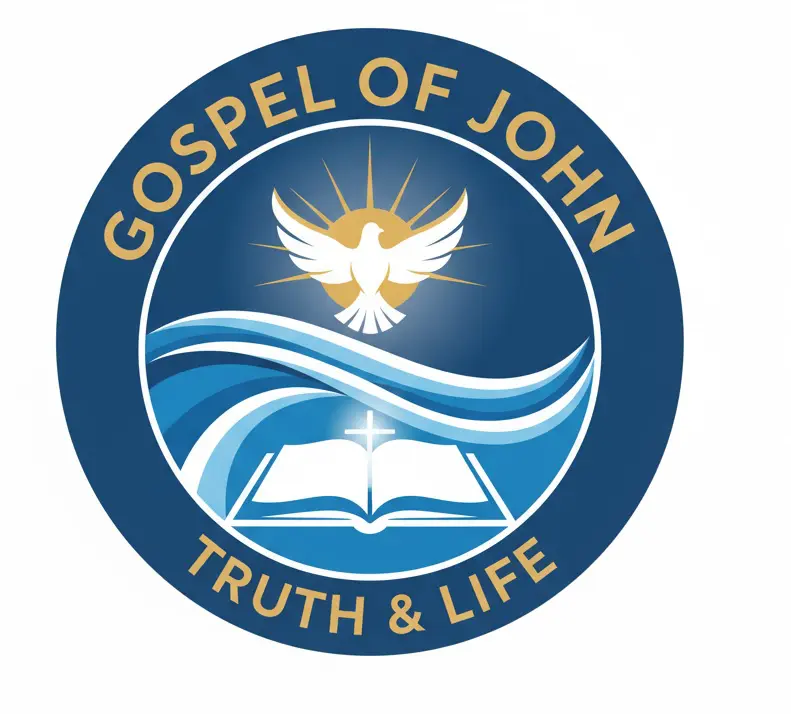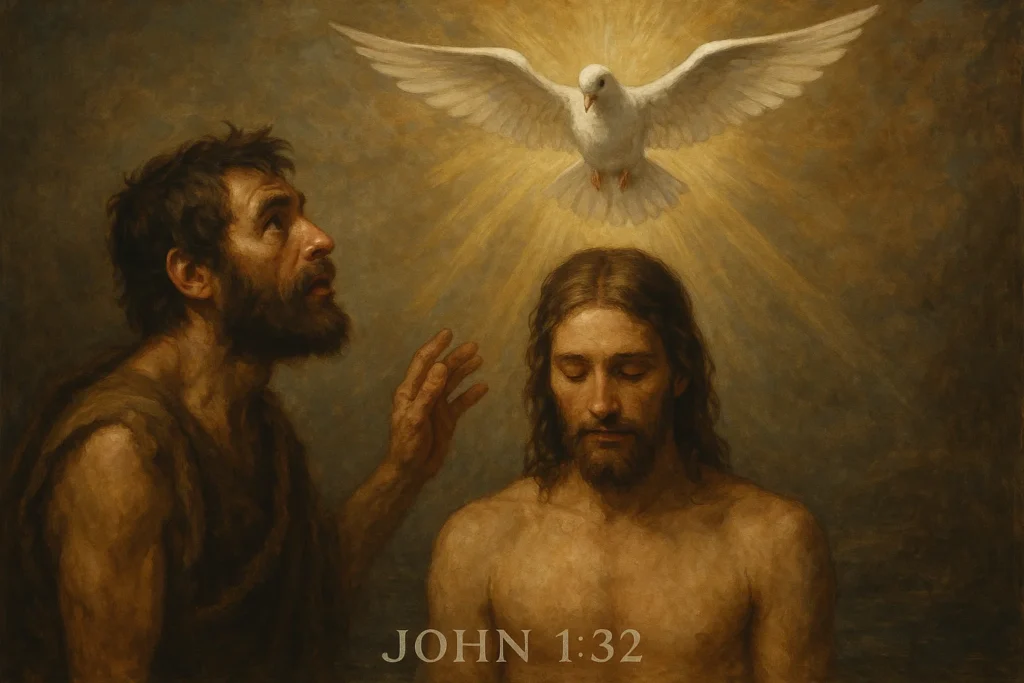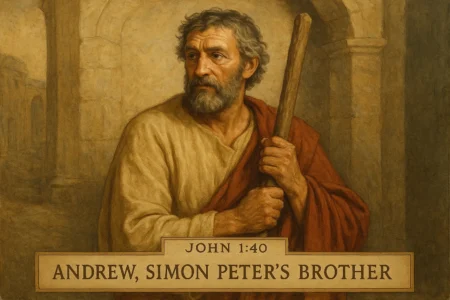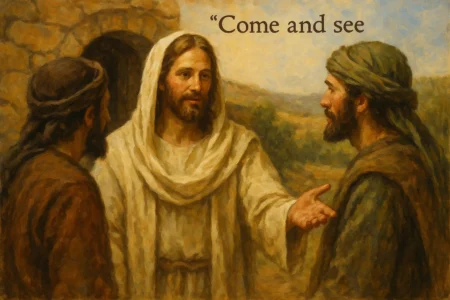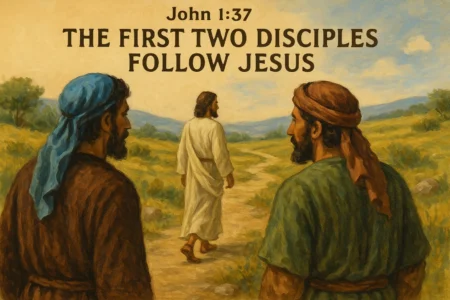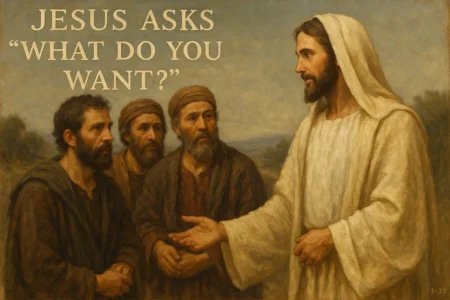The Jordan River.
Let’s be honest. It’s not the Mississippi. In many places, it’s a humble, winding, and often muddy stream. It’s a working-class river, not a majestic one.
And yet, on one perfectly normal day about two thousand years ago, this dusty, unassuming riverbank became the hinge upon which all of human history would turn. It became a theater for one of the most profound and mysterious events in the entire Bible: the baptism of Jesus.
John the Baptist is there. This is the man of the wilderness, a rugged prophet clothed in camel’s hair, his voice raw from preaching repentance. He is fulfilling his entire life’s purpose in this one moment. And then, it happens. As his cousin Jesus comes up from the water, the sky literally rips open. A voice thunders. The Spirit descends.
John’s testimony of this event is captured in a single, powerful, eyewitness sentence: “And John bore witness: ‘I saw the Spirit descend from heaven like a dove, and it remained on him.'”
That one verse, John 1:32, is so much more than just a beautiful piece of religious imagery. It’s a legal declaration. It’s a theological bombshell. It’s the official starting gun for the public ministry of Jesus Christ. If we want to truly understand our faith, we have to get our hands around this moment. We have to unpack it.
This John 1:32 commentary is our deep dive. We’re going to look at what John saw, what it meant, and why it still matters profoundly to you and me, right here, right now.
More in John Chapter 1 Category
Key Takeaways
- This is Sworn Testimony, Not a Vague Feeling: When John says, “I bore witness” (martyrein in Greek), he’s using a legal term. He’s not sharing a “warm fuzzy.” He is, in effect, taking the witness stand before all of history and swearing, “I saw this. It was real. It happened.”
- The Manner of a Dove, Not Just a Bird: The text uses a simile: the Spirit came down like a dove. Luke’s Gospel adds it was in “bodily form.” This means it was visible and physical, but its manner was dove-like: gentle, fluttering, pure, and deliberate. It wasn’t a violent, chaotic, or scary event. It was a gentle arrival.
- “New Creation” Was Just Launched: The dove is a direct callback to two massive Old Testament stories: the Spirit “hovering” over the waters of the original creation (Genesis 1:2) and the dove bringing peace to Noah after the flood (Genesis 8). This moment at the Jordan is the start of God’s new creation.
- “Remained” is the All-Important Word: The most crucial word here is “remained” (menein). In the Old Testament, the Spirit would come upon prophets for a task and then, often, leave. Here, the Spirit descends and stays. He abides. He dwells permanently on Jesus. This signifies Jesus’ unique, divine nature.
- The Whole Trinity Shows Up: This isn’t a solo act. It’s one of the clearest pictures of the Triune God in the Bible. The Father speaks His affirmation from heaven. The Son stands in the water, identifying with us. The Spirit descends to anoint the Son for the work ahead.
What’s the Big Deal About John’s Testimony?
To really get the full impact of this verse, we have to put ourselves on that riverbank. Imagine the scene. A crowd is gathered. There’s a buzz of nervous expectation. This wild man, John, has been preaching fire and brimstone, and people are taking him seriously. They’re flocking to him, confessing their sins, and being baptized as a sign of repentance.
Then, Jesus wades into the water. His own cousin.
John, recognizing who this is, panics. He tries to stop Him. “I need to be baptized by you, and do you come to me?” (Matthew 3:14). But Jesus insists. “Let it be so now, for thus it is fitting for us to fulfill all righteousness” (Matthew 3:15).
So, John does it. He baptizes his Lord. And as Jesus comes up from the water, the sky tears open.
Why Does John Say He “Bore Witness”?
This isn’t casual language. Not by a long shot. The Greek word for “witness” is martyrein. It’s the word from which we get our English word “martyr.” It’s a legal term, through and through.
I served on jury duty once. The entire case rested on a single eyewitness to a car accident. The defense lawyer kept hammering one simple point at her. “Did you see the light was red? Not, did you think it was red? Not, did you feel it was red? Did you, with your own two eyes, see it?”
That’s exactly what John is doing here. He is getting on the witness stand of history, raising his right hand, and making a formal, factual declaration: “I saw it. With my own two eyes. It happened.”
This testimony is the entire foundation of John’s ministry. He wasn’t the main event. He knew that. He was the advance man, the opening act, the one sent to point to the real Messiah.
And how would he know Him? God had given him a specific, visual sign to look for. “He who sent me to baptize with water said to me, ‘He on whom you see the Spirit descend and remain, this is he who baptizes with the Holy Spirit'” (John 1:33).
John 1:32 is the public declaration that the sign has been given. It’s John’s “That’s Him!” moment. His life’s work was now complete.
But Why Did Jesus Even Need to Be Baptized?
This is one of the best questions you can ask about this story. John’s baptism was for “repentance for the forgiveness of sins” (Mark 1:4). If Jesus was sinless (and the Bible is clear He was, e.g., Hebrews 4:15), why would He undergo a ritual for sinners?
It’s a beautiful mystery, but it’s not an unsolvable one.
First, it was about obedience. It was Jesus, in an act of perfect submission, fulfilling every requirement of God’s plan. This is what He meant by “fulfill all righteousness.” He was stepping into the role of the perfect, obedient representative for all of us.
Second—and this is the big one—it was about solidarity. Jesus steps into the water with sinners. He doesn’t stand on the shore, clean and separate, pointing at the mud. He walks down into the mud with us. It’s a profound act of saying, “I am with you.” His baptism is a preview of the cross, where He would go all the way, taking our sin on Himself (2 Corinthians 5:21).
Finally, this was His public commissioning. This was the moment the Spirit anointed Him for the work He came to do. The word “Messiah” (Hebrew) and “Christ” (Greek) both mean “Anointed One.” This event at the Jordan was His official anointing.
So, Did Anyone Else See the Dove?
This is a fantastic question that Bible scholars love to discuss. The Gospel of John, which we’re focusing on, centers intently on John’s personal testimony.
But what about the other Gospels?
- Matthew and Mark’s accounts say Jesus “saw the heavens opening and the Spirit like a dove descending on him” (Mark 1:10).
- Luke’s Gospel gets even more specific, saying the Spirit descended “in bodily form, like a dove” (Luke 3:22). This “bodily form” (sōmatikō eidei) strongly suggests it wasn’t just an internal feeling but a visible, physical-like manifestation.
So, who saw it?
- Jesus certainly did. This was His anointing. He was the primary recipient.
- John the Baptist absolutely did. This was the divine sign he had been waiting for.
But what about the crowd standing on the shore? It’s very unlikely. This appears to be a private revelation for the key players, intended for a public testimony. It wasn’t a magic show for the masses. It was a divine, sacred transaction between the members of the Trinity, with John as the designated legal witness. The witness was John, and his testimony is what the Church is now built upon.
Why a Dove? What’s the Symbolism?
This is the heart of the verse, isn’t it? Of all the things the Spirit could have looked like, why a dove?
Why not a lion, symbolizing kingship and power? Why not an eagle, for sovereignty and vision? Why not fire, as He would later appear at Pentecost, symbolizing purity and judgment?
The choice is deliberate. It’s incredibly profound. And it’s loaded with meaning.
Was It a Real Bird or Just Like a Dove?
Let’s look at the language again. John says the Spirit descended hōs (like, or as) a dove. Luke says “in bodily form, like a dove.” This combination is fascinating. It tells us two things: it had a visible form (it wasn’t just a feeling), but its nature was like a dove.
I remember once my young son and I were in a city park, feeding breadcrumbs to the birds. The pigeons were a chaotic mess. They were frantic, flapping, fighting, and descending on the food with a kind of desperate, jerky energy. They were aggressive.
But then, a single, white dove landed a few feet away. It didn’t flap wildly. It didn’t fight. It seemed to just… arrive. It hovered for a second, landed with impossible gentleness, and moved with a grace and peace that was totally different from the pigeons.
My son, who was just a toddler, pointed and said, “That one’s different. It’s calm.”
That, for me, is the perfect picture of this verse. The Spirit didn’t descend like a frantic, aggressive pigeon. He didn’t come like a bolt of lightning or a crashing wave of fire. He came like a dove—with gentleness, purity, peace, and deliberate intention. This was an arrival of grace, not of terror.
Was This a “New Creation” Moment?
You better believe it. For any first-century Jew standing on that riverbank, the image of a “dove” and “water” would immediately trigger two massive Old Testament memories. The first is Genesis 1.
In the very beginning, Genesis 1:2, the world is “formless and void,” covered in water and darkness. And what is God doing? “The Spirit of God was hovering over the face of the waters.”
The Hebrew word for “hovering” is merahepheth. It’s a beautiful, gentle word. It’s the same word used in Deuteronomy 32:11 to describe a mother eagle “fluttering” over her young in the nest. It’s an image of creative, life-giving, protective care.
Do you see the connection? As Jesus, the new Adam, the beginning of a new humanity, comes up out of the waters of baptism, the very same Spirit that “hovered” over the original creation now descends upon Him.
This is the beginning of the new creation. The old, fallen world is about to be remade.
What Does Noah’s Dove Have to Do With Jesus?
The second, and perhaps even more obvious, connection is to Noah in Genesis 8. The world has been judged and destroyed by a flood of water. How does Noah know the judgment is over? How does he know it’s safe to come out, that a new world is habitable again?
He sends out a dove. The first time, it comes back. The second time, it returns with a freshly plucked olive branch in its beak (Genesis 8:11).
The dove becomes the universal symbol of peace, of restoration, of God’s judgment ending and a new, clean beginning.
Now, look at the Jordan. Jesus has just stepped into the waters of judgment, identifying with sinful humanity. He comes out of the water, and the dove descends. It’s a sign to all of creation. The flood of sin is ending. The judgment is being dealt with. The new world is here, and peace between God and man is at hand through this one man, Jesus. He is the olive branch.
Are There Other, Hidden Meanings in the Dove?
Yes. While Creation and the Flood are the “big two,” the dove had other meanings in Jewish thought.
- A Symbol of Israel: In places like Hosea 7:11, Israel is called a “silly, easily deceived dove.” It was a symbol of the nation, often in its weakness or vulnerability. The Spirit descending as a dove on Jesus, the true Israel, could signify God’s redeeming and anointing His people, embodied in this one man.
- A Sacrifice for the Poor: In the Law of Moses, if you were too poor to afford a lamb for a sacrifice, what could you bring instead? A pair of turtledoves or pigeons (Leviticus 5:7). This was the sacrifice Mary and Joseph themselves offered at Jesus’ dedication (Luke 2:24). The dove, then, is also a symbol of humility, of poverty, of God’s provision for the poor and lowly. The Spirit’s dove-like arrival wasn’t a show of wealth or worldly power; it was a sign of humble, sacrificial love.
What Does “And It Remained on Him” Really Mean?
This is it. This is the part of the verse we all read over the fastest, but it’s arguably the most revolutionary phrase in the entire passage.
“I saw the Spirit descend… and it remained on him.”
Why Is “Remained” the Most Important Word Here?
The Greek word John uses here is menein. It doesn’t just mean “to stay for a bit” or “to land.” It means “to abide, to dwell, to make a home, to remain permanently.”
This one word changes everything.
This word menein is one of the most important words in John’s entire Gospel. It’s the same word Jesus uses later in John 15, “Abide (menein) in me, and I in you. As the branch cannot bear fruit by itself, unless it abides (menein) in the vine, neither can you, unless you abide (menein) in me.” It’s a word of deep, permanent, relational union.
In the Old Testament, the Holy Spirit operated very differently. The Spirit would “come upon” or “rush upon” individuals for a specific task.
- The Spirit rushed upon Samson for a temporary feat of supernatural strength (Judges 14:6).
- The Spirit came upon Saul to prophesy and anointed him as king (1 Samuel 10:10).
- The Spirit was upon Isaiah to preach (Isaiah 61:1).
But this anointing was often temporary. It was task-oriented. And it could be taken away. The most tragic verse in King David’s life, after his sin with Bathsheba, is his desperate plea in Psalm 51: “And take not your Holy Spirit from me!” He knew, as King Saul had tragically experienced, that the Spirit’s presence could be withdrawn.
But with Jesus, something entirely new is happening. The Spirit doesn’t just visit. He arrives. He descends. And He remains.
He makes His home.
How Is This Different from Any Other Anointing?
This permanent “remaining” signifies that Jesus is not just another prophet. He is not just another king in the line of David. He is something entirely different in kind, not just in degree.
The Spirit dwells in Him fully, completely, and permanently. As the Apostle Paul would later write, “For in him all the fullness of God was pleased to dwell” (Colossians 1:19), and “in him the whole fullness of deity dwells bodily” (Colossians 2:9).
He doesn’t just have the Spirit for a task; He is in perfect, eternal union with the Spirit. This permanent, abiding presence is what makes Him unique. It’s the sign that He is the one who “baptizes with the Holy Spirit,” because He possesses the Spirit in fullness.
I’ll never forget the first sermon I ever prepared. I was 22, in seminary, and asked to preach at a small country church on a Sunday night. By Saturday, I was a complete wreck. My notes were a mess. I was terrified. I was convinced I was going to fail God, the church, and myself. I remember pacing my tiny apartment, practically in tears, just praying over and over, “God, I can’t do this. I cannot do this. I need your help. Please, just show up.”
I didn’t feel a lightning bolt.
I didn’t hear a voice. But as I sat there, a profound sense of calm just… settled on me. It wasn’t a jolt of energy. It wasn’t a rush of adrenaline. It was a deep, quiet, abiding peace. The fear didn’t totally vanish, but it lost its power. A new presence was in the room, and it wasn’t leaving. It was the feeling of menein. It was a “remaining.”
That tiny human experience was just the faintest shadow of what John saw. John wasn’t seeing Jesus get a temporary “helper” for His big sermon. He was seeing the full, permanent, abiding union of God the Son with God the Spirit. This was the anointing for the salvation of the entire world.
What Does This John 1:32 Commentary Mean for Us?
This event isn’t just a fascinating piece of historical trivia. It’s the model for our own spiritual lives. The anointing of Jesus is the source and the promise of our own.
Did Jesus Become the Son of God at Baptism?
Let’s be crystal clear on this point: an emphatic NO.
This was not a promotion. This was not a magical moment where the human Jesus became the Son of God. That’s an ancient heresy called “Adoptionism,” and it’s been rejected by the Church from the very beginning because it’s just plain wrong.
Jesus was, is, and always will be the eternal Son of God (John 1:1).
The voice from heaven didn’t say, “You have now become my beloved Son.” It said, “This is my beloved Son, with whom I am well pleased” (Matthew 3:17). It was a confirmation of an eternal reality, not a coronation of a new one.
So what did happen? This was Jesus’ official, public anointing for His earthly ministry. He was stepping into His role as the Christ, the Messiah, the “Anointed One.” The Spirit was empowering His human nature for the work He came to do—to heal, to preach, to suffer, to die, and to rise again, all as a man in perfect obedience to the Father.
How Does This Anointing Connect to Us?
Here’s the good news. Here’s where it gets personal. Because Jesus was anointed with the Spirit that “remained,” He could then give that same Spirit to us. This is the entire promise of the New Covenant.
After His resurrection, Jesus told His disciples He would send a “Helper,” the Holy Spirit, who would be with them and in them (John 14:16-17). And what word does Jesus use to describe the Spirit’s relationship with us? “He abides with you, and he will be in you.”
Menein. The exact same word.
The same Spirit that descended like a dove and remained on Jesus is the same Spirit that, when you become a believer, takes up permanent residence in you. He doesn’t just visit you when you’re praying hard or leave you when you have a bad day. He abides. He remains. He has made His home in you (1 Corinthians 3:16). This is the staggering, life-changing good news of the Gospel.
What Did This Testimony Empower John to Do?
This sight, this confirmation, changed everything for John the Baptist. It gave him the absolute, unshakable certainty he needed for the final, and most important, phase of his ministry.
Look what happens in the very next verses. His entire message shifts.
- John Testifies: The next day, he makes his formal declaration: “I have seen and have borne witness that this is the Son of God” (John 1:34). His mission is complete. He has found the one.
- John Redirects: The day after that, John sees Jesus walking by. He turns to his own disciples, the men who had followed him into the desert, and he points. “Behold, the Lamb of God!” (John 1:36).
And what did his disciples do? “The two disciples heard him say this, and they followed Jesus” (John 1:37).
Because he saw the Spirit descend and remain, John knew this was not just the King (Messiah), but also the Sacrifice (the Lamb). He could now, with perfect confidence, hand his entire life’s work over to Jesus. His job was done. “He must increase,” John would later say, “but I must decrease” (John 3:30). This moment was the pivot.
The Final Witness: The Dove and the Lamb
John 1:32 is the pivot point of the Gospels. Without this verse, we don’t have the divine, eyewitness confirmation of who Jesus is. John’s role as the witness was to see the sign and then tell the world what he saw.
And what a picture he painted.
This single event is a beautiful, complete revelation of our God.
- The Father speaks His love and affirmation from heaven.
- The Spirit descends in gentleness, purity, and peace to anoint and empower.
- The Son stands in the water, in perfect solidarity with us, ready to begin the work of salvation.
For a deeper dive into the historical and theological context of the Holy Spirit’s role in the life of Christ, the articles from Dallas Theological Seminary offer some excellent and trustworthy academic perspectives.
The Spirit descended like a dove, the symbol of peace. And He remained on the one who, as the Lamb, would make peace between God and humanity by “taking away the sin of the world” (John 1:29).
This John 1:32 commentary shows us that this verse is far more than a historical snapshot. It is the divine commissioning of our King. It is the anointing of our Savior. And it is the beautiful, powerful promise of the very Spirit who now lives and remains in all who call on His name.
It is the moment the new creation began.
FAQ
What is the significance of the Spirit descending like a dove at Jesus’ baptism?
The Spirit descending like a dove signifies gentleness, purity, and peaceful arrival, highlighting the beginning of God’s new creation and emphasizing Jesus’ divine nature and His anointing for His ministry.
Why did Jesus, who was sinless, need to be baptized according to the biblical account?
Jesus’ baptism was about obedience, fulfilling God’s plan, and solidarity with sinners, symbolizing His identification with humanity and His future role in taking on the world’s sins, as well as His public commissioning for His earthly mission.
Who saw the Spirit descend during Jesus’ baptism, and what does this imply about the event?
Jesus and John the Baptist saw the Spirit descend, with Luke describing it as in bodily form like a dove. The crowd likely did not see it, implying it was a divine revelation intended as a private sign for the key players, confirming Jesus’ divine anointing.
How does the symbolism of the dove at Jesus’ baptism relate to Old Testament stories like Genesis and Noah’s Ark?
The dove is linked to Genesis, representing the Spirit hovering over the waters at creation, and to Noah’s Ark, symbolizing peace, hope, and new beginnings after judgment. It signifies the start of a new creation where peace with God is restored through Jesus.
